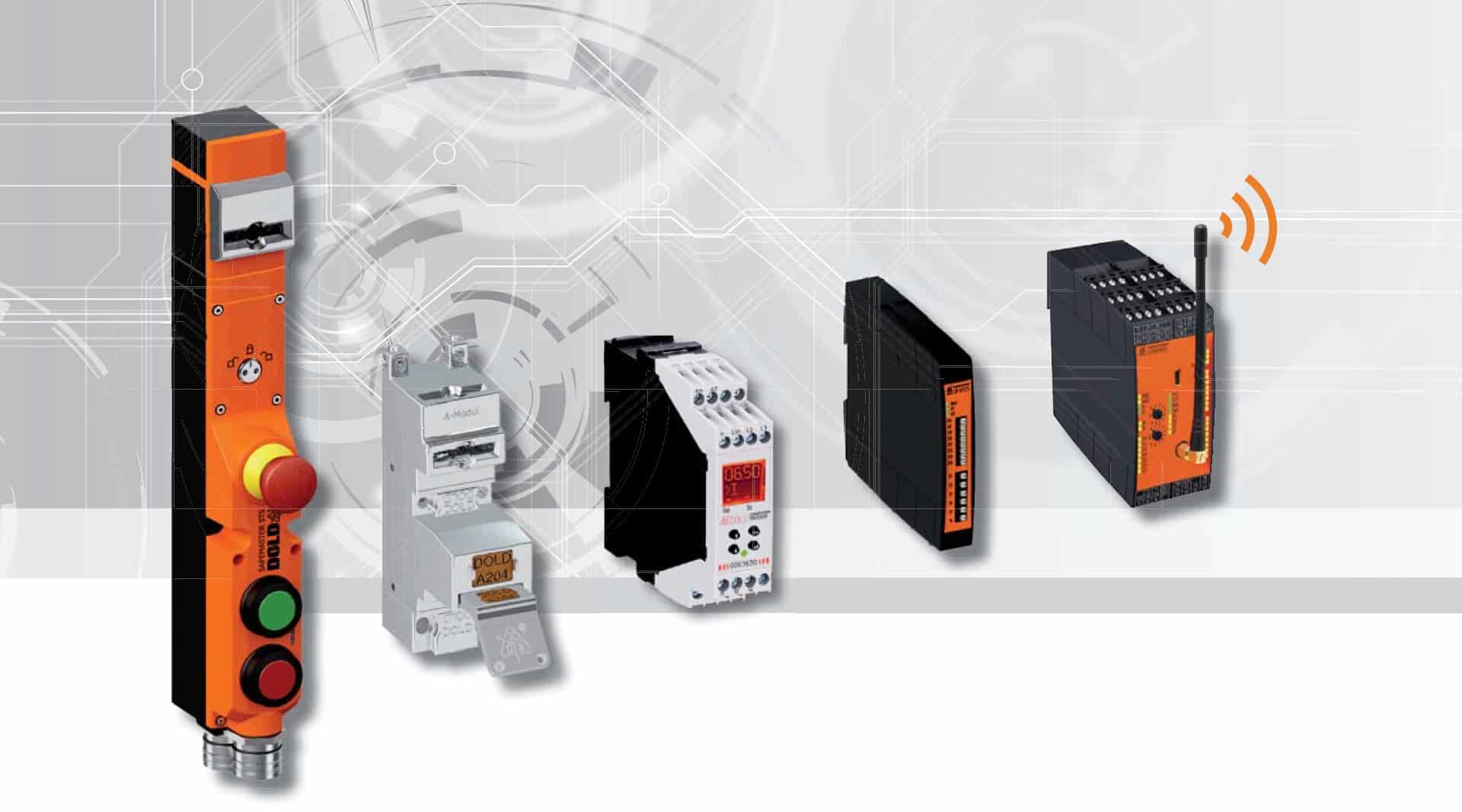Importance of Industrial Safety The Role of Monitoring Systems In industrial environments, safety monitoring systems serve as the first line of defense against operational hazards.…
Importance of Industrial Safety
The Role of Monitoring Systems
In industrial environments, safety monitoring systems serve as the first line of defense against operational hazards. These systems detect anomalies in equipment behavior—such as overheating, overcurrent, or mechanical failure—and immediately signal or stop the machinery to prevent accidents.
Benefits of Reliable Safety Mechanisms
Reliable safety sensors like those from Dold reduce downtime, protect employees, and ensure compliance with safety regulations. They help mitigate the risks of mechanical faults, electrical overloads, and operator errors by providing real-time feedback and enabling automatic shutoffs when thresholds are breached.
Dold Sensors’ Innovative Safety Solutions
Product Description
Dold sensors are also engineered to support a wide nominal voltage range, typically from 24V to 240V AC/DC, allowing flexible deployment in global industrial environments. This compatibility enables easy integration with various control cabinet configurations and ensures that voltage fluctuations do not impact performance.
Dold sensors are precision-engineered devices designed to enhance the safety and efficiency of industrial automation systems. Each sensor is built with high-quality components and robust materials, ensuring consistent performance even under harsh environmental conditions. Whether used for current monitoring, standstill detection, or speed supervision, these sensors are tailored to meet the needs of machinery manufacturers, system integrators, and facility maintenance teams.
Dold’s safety sensors integrate easily with control systems, offering versatile mounting options and streamlined wiring. Their user-friendly configuration features, such as rotary switches and LED indicators, allow technicians to set parameters quickly and confidently. With wide input voltage ranges, compact enclosures, and support for multiple relay outputs, Dold sensors provide a comprehensive solution for safety-related automation challenges.
Overview of Dold Sensors’ Product Range
Dold also offers a selection of proximity sensors that detect the presence or absence of objects without physical contact. These sensors are ideal for position sensing, object detection, and end-stop verification in automated machinery. Proximity sensors by Dold are available in inductive, capacitive, and optical variants, depending on the sensing medium required.
They are designed for durability and precision, with fast response times and robust housings that withstand industrial environments. These sensors contribute to enhanced safety by initiating shutdowns or alerts when unexpected movement or misalignment is detected near machine zones.
Dold offers a broad selection of industrial sensors, including current and voltage monitors, standstill monitors, and multi-functional safety relays. Their sensor solutions integrate seamlessly with automation systems to monitor operating conditions and trigger predefined safety functions.
Key Technologies in Safety Solutions
Diagnostic Functions
Dold sensors feature advanced diagnostic capabilities that provide early warnings and performance insights to maintenance teams. These include LED status indicators, fault memory, self-diagnosing circuitry, and error code outputs. Diagnostic functions allow users to monitor sensor health in real time, detect wiring errors or internal malfunctions, and prevent unexpected downtimes. Integration with PLCs or monitoring systems enables automatic reporting, making Dold sensors a smart choice for predictive maintenance and industrial IoT environments.
Semiconductor Monitoring Outputs
Dold sensors are available with semiconductor monitoring outputs, offering high switching speeds and extended operational lifespans. These solid-state outputs are especially suited for applications requiring fast, frequent switching or where mechanical wear must be minimized. Semiconductor outputs also provide noise-resistant performance and are ideal for integration with PLCs and digital I/O systems.
Auxiliary Contacts
Dold supports auxiliary contacts for status indication and advanced diagnostics. These contacts operate independently of the main switching circuit and provide real-time status updates to HMIs or control systems. This enhances monitoring accuracy and contributes to predictive maintenance strategies.
Speed-Dependent Switching
Many Dold sensors incorporate speed-dependent switching capabilities, enabling outputs to activate or deactivate based on motor speed thresholds. This ensures safety mechanisms are only triggered when a machine is truly at rest or has reached a critical speed, helping to avoid false positives and improve operational efficiency.
Speed of Motors and Rotational Speed Monitoring
Dold devices offer precise monitoring of motor speed and rotational velocity. These features are critical in applications where operating speed directly impacts safety, such as in presses, conveyors, or rotating tools. By continuously tracking speed and alerting to deviations, Dold sensors prevent overspeed conditions, ensure safe deceleration, and maintain system stability.
Current Monitoring
Dold sensors excel in current monitoring applications by reliably detecting overcurrent, undercurrent, and phase failure conditions. These current monitoring functions are crucial for preventing equipment damage and ensuring uninterrupted operations in industrial settings. The ability to continuously supervise current flow allows for rapid detection of abnormal states, enabling automatic shutdowns or alerts.
Safe Monitoring
Safe monitoring features are integrated into Dold’s product range to guarantee compliance with machine safety standards. These features include redundancy, cross-circuit monitoring, and diagnostic feedback loops that verify the integrity of sensor operations. They ensure safe states are maintained even in the event of component failure.
Window Monitoring
Window monitoring, another advanced function offered by Dold, allows systems to supervise signals or operational parameters within a defined range or “window.” If values drift outside the acceptable window—either too low or too high—the system triggers an alarm or protective response. This is especially useful in applications where precise thresholds are critical to process integrity and operator safety. Dold employs advanced technologies such as sensorless monitoring, self-test diagnostics, and fail-safe relay logic. These features ensure dependable performance and rapid detection of faults, even in harsh industrial environments. In addition, current monitoring solutions play a crucial role in detecting anomalies such as overloads or phase failures, while devices with limited extent functions ensure controlled activation areas in machinery—improving precision and minimizing unnecessary intervention.
Dold sensors are also equipped with output contact configurations that provide safe feedback to control circuits. These contacts can be configured as normally open (NO), normally closed (NC), or changeover, and are designed to support fail-safe operations in conjunction with safety controllers. The durability and low contact resistance of Dold’s output contacts enhance signal reliability and help maintain consistent system behavior over extended periods.
Dold devices are designed with universal input ranges to accommodate various control voltages, making them versatile and adaptable to international applications. They support a wide nominal voltage range, allowing integration into both standard and custom control systems without requiring separate configurations.
Furthermore, Dold emphasizes rugged enclosure design in its sensors and safety modules. Housings are typically compact, DIN-rail mountable, and constructed from durable, heat-resistant materials. This ensures protection against dust, mechanical stress, and environmental factors, thereby extending product lifespan and reliability in demanding industrial settings.
Dold also supports auxiliary contacts for status indication and advanced diagnostics. These contacts provide additional signaling paths independent of the main switching circuit, allowing integration into HMI systems or central controllers for real-time operational visibility.
Many Dold devices are capable of processing impulse signals—short-duration signals used in control tasks such as toggling, resetting, or sequential activation. This functionality enhances compatibility with PLCs and advanced automation systems where momentary signal inputs are preferred for efficiency and safety logic.
Modern Dold sensors are compatible with current browsers and communication protocols used in industrial Ethernet and web-based monitoring interfaces. This allows operators to access diagnostics, settings, and real-time data through secure browser-based dashboards, increasing convenience and accessibility for maintenance and supervisory teams.
Advanced Monitoring Systems
Safe Standstill and Speed Monitoring
Dold’s speed monitoring systems not only detect whether motors have fully stopped but also track their rotational speed in real-time. These systems are crucial in scenarios where equipment must remain within safe speed limits to avoid mechanical failure or injury. Adjustable threshold settings and response delays allow precise control over machinery deceleration and safe reactivation conditions.
Dold’s standstill monitors ensure that motors have come to a complete stop before allowing access to hazardous areas. Speed monitors continuously evaluate motor RPMs and trigger safety actions if preset speed thresholds are exceeded, preventing mechanical hazards.
Sensorless Standstill and Frequency Monitoring
Dold’s sensorless technology determines motor status by analyzing voltage signals, eliminating the need for external sensors. This reduces wiring complexity and is especially useful in retrofitting older systems or protecting motors in inaccessible locations.
Safety Functions Compliance with DIN EN 61800-5-2
Dold monitoring devices are designed to meet the rigorous requirements of DIN EN 61800-5-2. This standard governs safety-related functions in drive systems, ensuring integration with functional safety architectures like SIL (Safety Integrity Level) and PL (Performance Level).

Sensorless Monitoring Techniques
Standstill Monitoring Without Sensors
Dold’s sensorless standstill monitors detect motion cessation by monitoring residual voltage, allowing safe access without additional hardware. This method is cost-effective and minimizes installation time.
Safety Gate Monitoring with Solenoid Interlocks
Combining sensorless standstill detection with solenoid interlocks on safety gates ensures the gate only opens once hazardous motion has ceased. Dold’s integrated systems enhance physical safety while maintaining process continuity.
SAFEMASTER STS Safety Switch System
Dold’s extensive range of safety switches includes both mechanical and electronic variants designed for guarding doors, hatches, and safety gates. These switches feature tamper-proof mechanisms, fail-safe contacts, and options for RFID coding to enhance machine access control. They are an essential part of comprehensive safety applications, enabling monitoring of entry points into hazardous zones and ensuring interlocks engage only under safe conditions.
Integration with Safe Drive Monitoring
The SAFEMASTER STS system from Dold combines mechanical safety switches with electronic monitoring. It integrates directly with drive controllers and safety relays, making it suitable for complex machinery that requires synchronized drive and gate control.
Enhancements in Operational Safety
With coded actuators, tamper-resistant designs, and modular construction, SAFEMASTER STS improves plant safety and flexibility. Operators benefit from reduced setup times and streamlined diagnostics during maintenance.
Electrical Safety Protocols
Monitoring in Unearthed (IT) Networks
Dold insulation monitors detect ground faults in unearthed (IT) systems to avoid equipment damage and operational hazards. These systems are essential in critical applications where continuity of power supply must be guaranteed.
Standards for Grounded (TN) Networks
In grounded (TN) systems, Dold residual current monitors and line voltage sensors ensure early fault detection. They comply with international standards to support safe shutdown procedures in case of abnormal current leakage or voltage drop.

Technical Questions
Dold sensors play a vital role in a wide range of safety applications, including emergency stop circuits, machine guard interlocking, load monitoring, and drive safety. They are trusted in industries such as packaging, manufacturing, energy, and transportation where equipment protection and personnel safety are non-negotiable priorities.
If you have technical questions or technical specifications inquiries regarding Dold sensors, safety applications, or integration challenges, please feel free to contact our support team. Common queries include:
- How do I select the right Dold sensor for my application?
- What are the wiring requirements for Dold standstill monitors?
- How can I configure window monitoring thresholds?
- What is the recommended method for integrating Dold sensors with PLCs?
- How do auxiliary contacts function during a fault condition?
- Can Dold sensors be used in outdoor or high-vibration environments?
- What is the response time for speed-dependent switching outputs?
- How do I perform functional tests for compliance with DGUV Regulation 3?
For further assistance, please contact: Email: [email protected] Phone: (02) 8459 7766 Address: Unit 15, 79/85 Mars Road, Lane Cove West, NSW 2066 Website: www.venusautomation.com.au
Standards and Compliance
DIN EN 61851-23 for DC Charging Stations
Dold’s monitoring solutions support safety compliance in DC charging stations for electric vehicles, in line with DIN EN 61851-23. Their sensors monitor voltage stability and ground insulation to prevent user exposure to live parts.
Periodic Inspections Under DGUV Regulation 3
To meet the requirements of DGUV Regulation 3, Dold sensors support periodic testing and automated logging. This facilitates documentation for compliance audits and improves overall workplace safety accountability.







